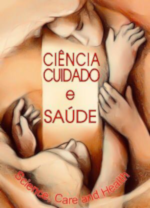Avaliação da mobilidade e fatores desencadeantes de quedas em idosos
Resumo
Objetivo: Avaliar a mobilidade funcional, e os fatores de riscos que desencadeiam quedas em idosos atendidos em uma Unidade Básica de Saúde. Método: Estudo descritivo, estudo de campo com abordagem quantitativa, realizado em uma Unidade Básica de Saúde com uma amostra de 197 idosos. Foi utilizado um formulário sobre os aspectos sociais de saúde do idoso, fatores de risco intrínsecos, extrínsecos e comportamentais que desencadeiam as quedas e o teste de mobilidade funcional. Utilizaram-se métodos estatísticos descritivos e inferenciais como teste de D’Agostino-Pearson, Qui-Quadrado(10), teste t de Student e Análise de Variância (ANOVA). Resultados: A maioria dos idosos tinham escolaridade fundamental incompleto (65.5%), casados (45.7%), que residem com filho (54.8%), lazer e televisão (47.2%) e auto percepção da saúde regular (46.7%) e sexo feminino (70.1%). Entre os fatores relacionados a maior probabilidade de risco de queda estão: presença de fratura, luxação e dificuldade para andar, iluminação ruim na residência, utilização de 5 ou mais medicamentos. Conclusão: Percebe-se nos resultados que os idosos têm risco de queda, mas, ainda apresentam uma mobilidade funcional adequada nos idosos mais jovens.
Downloads
Referências
Silva NTF, Ribeiro RCHM, Galisteu KJ, Cesarino CB, Pinto MH, Beccaria LM. Profile of older adult victims of trauma cared for in the emergency care unit of a teaching. Cienc Cuid Saude [on line] . 2018; 17( 2 ): 2-8. Doi: https://doi.org/10.4025/cienccuidsaude.v17i2.42045.
Queiroz SMB, Coutinho DTR, Almeida PC, Guedes MVC, Freitas MC. Clinical conditions of elderly who are victims of muscle-skeletal trauma1. Cienc Cuid Saude [on line] . 2016; 15( 3 ):530-537. Doi: https://doi.org/10.4025/cienccuidsaude.v15i3.28482.
Cunha P, Pinheiro LC. The role of physical exercise in the prevention of falls in the elderly: an evidence based review. Rev. port. med. geral. fam, [S.I.] . 2016; 32,( 2 ): 96- 100. Doi: https://doi.org/10.32385/rpmgf.v32i2.11732.
Possamai-Menezes L, Stamm B, Tambara-Leite M, Hildebrandt L, Kirchner R. Falling is a part of life: Falls risk factors to the elderly. Rev Fund Care Online [Internet] . 2016; 8( 4 ): 5080-5086. Doi: http://dx.doi.org/10.9789/2175-5361.2016.v8i4.5080- 5086.
Abdala RP, Barbiere Junior W, Bueno Junior CR, Gomes MM. Gait Pattern, Prevalence of falls and fear of falling in active and sedentary Elder women. Rev Bras Med Esporte [Internet] . 2017; 23( 21 ): 26-30. Doi: http://dx.doi.org/10.1590/1517- 869220172301155494.
Morsch P, Myskiw M, Myskiw JC. Falls’ problematization and risk factors identification through older adults’ narrative. Ciênc. Saúde Coletiva [Internet]. 2016; 21( 11 ): 3565- 3574. Doi: http://dx.doi.org/10.1590/1413-812320152111.06782016.
Bennett J, Vêra I, Sena K, Lemos M, Lucchese R, Silva G. Evaluation and intervention of equilibrium in the elderly. Rev. Enferm. UFPE on line [Internet]. 2018; 12( 9 ): 2479-2497. Doi: https://doi.org/10.5205/1981-8963-v12i9a234724p2479- 2499-2018.
Nascimento JS, Tavares DMS. prevalence and factors associated with falls in the elderly. Texto Contexto – enferm. 2016; 25( 2 ): 1-9. Doi: http://dx.doi.org/10.1590/0104-07072016000360015.
Lima FFO, Ferreira JB, Reis LA, Santos KT, Lima LS, Morais KCS. Sociodemographic profile and level of functional dependence of the elderly at risk of falls. Id on line. 2017; 11(39): 164-178. Disponível em: https://idonline.emnuvens.com.br/id/article/view/985.
Gaspar ACM, Azevedo RCS, Reiners AAO, Mendes PA, Segri NJ. Factors associated with fall prevention practices in older adults. Rev. Enferm. Esc. Anna Nery. 2017; 21 ( 02 ): 01-08. Doi: https://doi.org/10.5935/1414-8145.20170044.
Perseguino MG, Horta ALM, Ribeiro CA. The family in face of the elderly’s reality of living alone. Rev Bras Enferm. 2017; 70( 2 ):235-241. Doi: https://doi.org/10.1590/0034-7167-2016-0398.
Naman M, Streit IA, Fortunato AR, Marinho A, Mazo GZ. LEISURE AT DIFFERENT STAGES OF LIFE OF CENTENARIANS. Licere. 2017; 20 ( 1 ) : 201- 220. Doi: https://doi.org/10.35699/1981-3171.2017.1593.
Dresch FK, Barcelos ARG, Cunha GL, Santos GA. Auto perceived health condition and prevalence of chronic diseases nontransmissible in elderly family health strategy. Rev. Conhec. online. 2017; 2( 9 ): 118-127. Doi: https://doi.org/10.25112/rco.v2i0.1183.
Chehuen Neto JA, Brum IV, Braga NAC, Gomes GF, Tavares PL, Silva RTC, et al. Fall awareness as a determining factor of this event among elderly community residents. Geriatr Gerontol Aging. 2017; 11( 1 ):25-31. Disponível em: http://ggaging.com/details/413/pt-BR.
Paula Júnior NF, Santo SMA. Epidemiology of accidental falls among the elderly: survey of the period 2003-2012. Rev. Min. Enfer. 2015; 19( 4 ) : 994-1004. Doi: http://www.dx.doi.org/10.5935/1415-2762.20150075.
Guerra HS, Bernardes DCF, Santana JA, Barreira LM, Sousa RA, Neves CM. Evaluation of the risk of falls in elderly people in the community. Rev. Saúde.Com . 2017; 13( 2 ): 879-886. Doi: http://dx.doi.org/10.22481/rsc.v13i2.434.
Reis LA, Rocha TS, Duarte SFP. Falls: risk and associated factors in institutionalized elderly. Rev. Baiana enferm. 2014; 28( 3 ): 225-234. Doi: http://dx.doi.org/10.18471/rbe.v28i3.12303.
Luzardo AR, Paula Júnior NF, Medeiros M, Lima LSB, Wolkers PCB, Santos SMA. Fall of elderly: revealing vulnerability situations. REME – Rev Min Enferm. 2017; 21:e-1025. Doi: http://www.dx.doi.org/10.5935/1415-2762.20170035.
Carvalho CJA, Bocchi SCM. The elderly recognizing themselves as vulnerable to falls in the concreteness of the femoral fracture. Rev. Bras. Enferm. 2017; 70( 2 ): 279- 286. Doi: https://doi.org/10.1590/0034-7167-2016-0392.
Rosa BM, Abreu DPG, Santos SSC, Silva BT, Ilha S, Martins NFF. Association between fall risks and medication use in the elderly. Rev baiana enferm. 2017;31( 4 ):e22410. Doi: http://dx.doi.org/10.18471/rbe.v31i4.22410.
Copyright (c) 2020 Ciência, Cuidado e Saúde

This work is licensed under a Creative Commons Attribution-NonCommercial 4.0 International License.




















